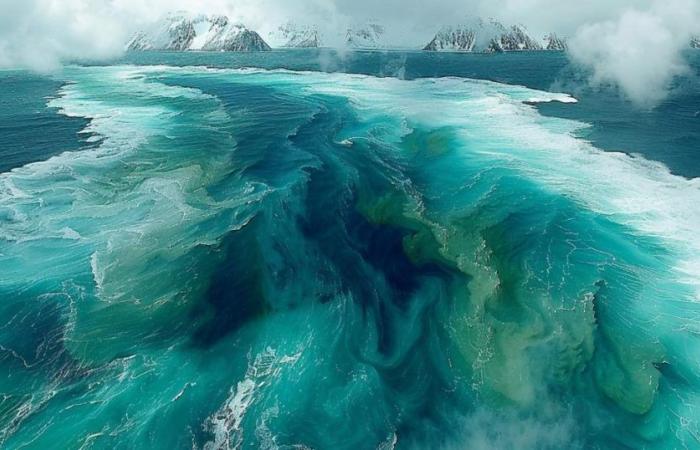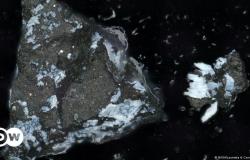It’s not just Greenland that is turning green. The Arctic Ocean is warming faster than anywhere else on Earth (four times more) and what is usually an ocean of crystal-clear turquoise waters is turning into increasingly greener aquatic strips. And the main culprit could be climate change. This is confirmed by a new study by the University of Manitoba and the University of Colorado reported in the magazine. Geophysical Research Letters.
Sea ice that once covered a vast expanse of ocean year-round is now seasonal, melting and disappearing from large areas during the summer months. The ice mass continues to thin and the depth of the snow has been decreasing in recent decades. In the last times, satellites have recorded color differences gradual and subtle changes in 56% of Earth’s oceans, an area that is larger than all of Earth’s land mass combined.
An ocean on Earth is turning green due to climate changeMidjourney/Sarah Romero
Why does the ocean change color?
Thicker ice and snow mean less light can reach the algae beneath the ice. Thus, an unexpected consequence of the melting of ice in the Arctic goes far beyond the sad images we have seen of polar bears seeking refuge in small pieces of ice in the middle of the ocean. The color of the ocean reflects the growth of living organisms in the surface waters of the terrestrial seas. Although this color change is not visible to the naked eye, satellite studies can map the change.
“As ice and snow thin, more light penetrates to the bottom of the sea ice. This changing light regime has the potential to impact the entire marine ecosystem, starting with algae,” explains Julienne Stroeve, a researcher at the University of Manitoba and the University of Colorado.
It is as if the algae turned the water into a kind of underwater grass; This ‘grass’ is the basis of the Arctic food web: zooplankton feed on it, which in turn feeds fish, seals and, ultimately, polar bears.

The recent report on the state of the climate in Europe, published in April 2024 by the European Union’s Copernicus Climate Service, found that chlorophyll, a photosynthetic pigment found in phytoplankton and plants that gives them their green hue, was 200% to 500% higher than average in the Norwegian Sea and Atlantic Ocean to the north of the United Kingdom in April 2023, for example. A sign, according to scientists, of warming ocean temperatures.
And we have new data. The European Space Agency’s Cryosat satellite has been monitoring Earth’s polar ice for 14 years. By combining this information with that of Copernicus Sentinel-3 and NASA’s ICESat-2, they have achieved model the penetration of light through ice.
The result is that The Arctic is experiencing a warming trend, with thinner ice and earlier melting allowing more sunlight to reach the ocean waters beneath the ice and earlier algal blooms to occur. If there is less snow, it has a considerable influence, since there is greater penetration of light and enables flowering not only much earlier but also more massive.
Before, the Arctic was just a frozen mass of white and blueMidjourney/Sarah Romero
And why is this negative?
The implications are very significant for the planet, as this early and severe algae bloom can alter the delicate balance of the arctic ecosystem. With more light, the algae would produce different nutrients than usual, something that could alter the entire ocean food web. Species richness would decrease in the tropics and increase dramatically in temperate and subpolar waters, causing further unknown knock-on effects on interconnected food webs and the fish that depend on these creatures.
“Understanding the photosynthetically active radiation that penetrates sea ice will support broader studies to understand what is happening to life in the Arctic Ocean due to climate change,” says Stroeve.
“The rapid changes taking place in the Arctic will have widespread consequences that will affect us all,” also notes Tommaso Parrinello, CryoSat mission director.
In essencethe important thing is not the color of the water itself, but that change in color reflects a profound transformation in the ecosystem. And we do not know what fate will await the Arctic with this unstoppable push of human-driven climate change.
It’s all because of climate changeMidjourney/Sarah Romero
References:
- Geophysical Research Letters.Mapping Potential Timing of Ice Algal Blooms From Satellite JC Stroeve, G. Veyssiere, C. Nab, B. Light, D. Perovich, J. Laliberté, K. Campbell, J. Landy, R. Mallett, A. Barrett, GE Liston, A. Haddon, J. Wilkinson First published: 17 April 2024 DOI: https://doi.org/10.1029/2023GL106486 This article was corrected on 13 MAY 2024.
- R. Treharne et al. Arctic browning: Impacts of extreme climatic events on Heathland ecosystem CO2 fluxes. Global Change Biology. 2018;1–15. doi:10.1111/gcb.14500
Ice lossMidjourney/Sarah Romero






